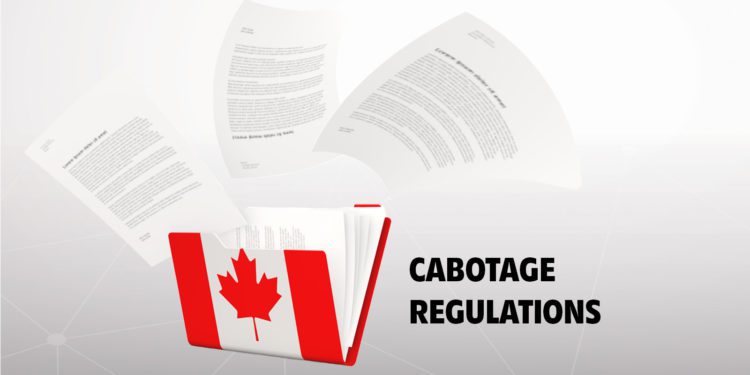Canadian Cabotage and Business Aviation: 6 Things you Need to Know

Cabotage issues are taken seriously in Canada, and unauthorized business aviation aircraft movements may result in substantial penalties. The good news is that a wide range of private non-revenue and charter (non-scheduled commercial) movements within Canada are possible under the current U.S.-Canada Open Skies policy. Best practice is to confirm in advance with your 3rd-party provider which cabotage operations are and are not possible to and within Canada.
1. Know the definition of cabotage for Canada
Cabotage is the transport of goods or passengers between two points in the same country by an aircraft registered in another country. International legs – for which an aircraft flies to a country to drop off passengers or to pick up passengers departing the country – are not considered cabotage.
2. Know that an Open Skies agreement has been in place with Canada since early 2012
An Open Skies agreement between the U.S. and Canada was signed in January of 2012. Currently, the U.S. has Open Skies agreements with Canada, the European Union, Switzerland, Australia and Japan. This agreement eases restrictions on U.S. and non-U.S. carriers to operate charters within each other’s territories. In many cases, it allows operators to move international passengers between any point, or points, in the foreign country with unlimited stopovers, as long as those movements are part of an original charter contract. A U.S.-based charter carrier, transporting U.S. or international passengers, may take passengers into Canada and move them around in Canada freely. There are additional considerations and restrictions, however, if you’re moving Canadian nationals within Canada.
3. Be aware of cabotage risks regarding charter movements in Canada
It’s not always easy to determine what is and what is not allowed with regard to cabotage in Canada. All arrangements for domestic charter movements by non-Canadian carriers within Canada must be made in advance, and you cannot offer charter services while in Canada. If a cabotage-related violation occurs, you may be subject to fines or seizure of your aircraft. Any non-Canadian operator involved in an unauthorized cabotage movement will be deemed to have imported the aircraft into Canada for the purposes of that flight, and the value of the aircraft may then be subject to a goods and services tax (GST).
4. Know what’s permitted in terms of cabotage
Canada uses scenario examples to determine and illustrate cabotage issues. A private operation may pick up and move passengers, including Canadian nationals, within Canada, if passengers are related to the business (employees, investors, customers) and are not compensating the aircraft owner for the flight. On the charter side, it’s permitted to move passengers, including Canadian nationals, within Canada, as long as the non-Canadian registered aircraft flight originates from outside Canada, and all legs/passengers are part of a contract. Additionally, you can arrive from outside of Canada with crew only, pick up passengers along your route within Canada and transport them to multiple locations, as long as any of the passengers picked up exit outside of Canada with the same aircraft. The same applies to cargo and livestock. If any passenger that is picked up within Canada and dropped off while in Canada (never to board again), then this is considered cabotage; the passenger or passengers picked up must have an agreement to exit the country with the aircraft. Failure to comply with these rules and regulations can lead to fines and revocation of a Canadian license.
5. Know that aircraft substitutions are possible
As long as your operation to and within Canada is part of an original charter agreement, an operator is free to substitute aircraft, or aircraft type, for maintenance-related or other issues.
6. Know that, in some cases, cabotage rules affect private flights
Usually there are no cabotage issues with private non-revenue operations, so long as passengers are associated with the company, and no compensation is paid for the flight. It’s best to check D211-42-43 regulations as they pertain to business aviation aircraft operations in Canada. Be aware that a private non-revenue operator is not usually permitted to come into Canada empty for the sole purpose of moving passengers between two points in Canada. A charter operator may, however, drop off passengers in Canada, reposition out of the country and return to transport the same passengers within Canada, as long as this is all part of an original charter contract. Always confirm all planned Canadian charter scenarios with your 3rd-party provider – for clarity on potential cabotage issues – prior to operating to and within Canada. You may also contact the Canadian Border Information Service (BIS) for more information.
7. Be aware of additional reading
To learn more about cabotage and business aviation, we also recommend you read this article by Marshall Weber on how cabotage regulations may impact your flight.
Conclusion
If you’re unsure of the possible impact of cabotage regulations on planned private non-revenue or charter flights to Canada, it’s best to check with your 3rd-party provider or directly with the Canadian Border Services Agency (CBSA). Non-Canadian-based operators are permitted to conduct a wide range of point-to-point movements within Canada but must be diligent in avoiding particular scenarios that may subject them to cabotage penalties.
Questions?
If you have any questions about this article, contact me at adamhartley@univ-wea.com.




